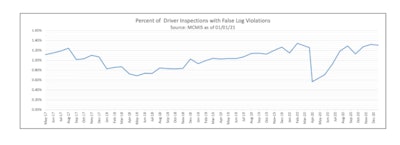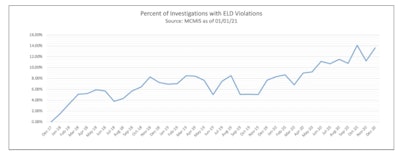The Federal Motor Carrier Safety Administration (FMCSA) on Wednesday presented its 20th annual Analysis, Research, and Technology Forum, with a wide-range of speakers from the agency presenting on topics from truck crash and fatality statistics, to trends in enforcement and inspections, emerging technologies like autonomous and electric vehicles, and more.
The forum, held in a virtual format and broadcast live via Microsoft Teams, also featured a brief address from the agency’s Acting Administrator, Meera Joshi, who will hold the role until President Joe Biden nominates and the Senate confirms a new administrator.
Here are six quick takeaways from FMCSA’s ART forum:
Remote/offsite safety audits of motor carriers are here to stay.
CCJ documented the surge in offsite/remote safety audits and compliance reviews over the past year. That trend is here to stay, said Joe DeLorenzo, FMCSA head of enforcement.
The agency so far has “felt good about how [offsite audits] worked and how the agency was able to transition” quickly to those remote audits, he said. That was somewhat out of necessity when the pandemic hit, but it was also a stroke of good luck on the agency’s timing, he said.
FMCSA was already planning to leverage offsite/remote audits on a greater scale in carrier interventions in 2020. “The technology was in place,” he said. Last year’s “blended approach,” in which there was a rough 50/50 split in offsite versus onsite/in-person audits, is “where we were headed anyways,” he said. The pandemic simply sped up the implementation of remote audits.
So far, “remote investigations do not hamper our ability to discover violations,” he said.
[RELATED: Carrier compliance audits dipped in ‘20 – but offsite reviews skyrocketed]
For example, the violation rate of offsite audits was 92%, compared to 97% for onsite focused reviews and 91% for onsite comprehensive reviews. The “acute/critical” violation rate was 30% for offsite audits, compared to 48% for so-called onsite focused reviews and 56% for onsite comprehensive audits. “[We] continue to identify non-compliance of those carriers that are presenting us with some high risk,” DeLorenzo said, even via offsite audits.
When the pandemic eases, offsite audits will remain an enforcement tool for the agency, he added. “This shows we can do an even greater job” leveraging remote reviews, he said.
Acting FMCSA boss thanked industry for its work during the COVID pandemic.
Meera Joshi, who’s heading FMCSA on an interim basis under the Biden Administration’s DOT, gave a brief address Wednesday, offering a thanks to the industry for its work amid the COVID pandemic.
“Thank you all for your service in 2020 and your continued service this year keeping our vital supply chains running,” she said. “The world and our nation are changed forever. We see the value of interstate movement of people and freight — one you have always known the value of — is now much more apparent to a broader audience.”
She acknowledged the “challenges in a fast-growing, fast-changing industry,” and said the spotlight on interstate freight movement also brings a greater focus on highway safety. “Our safety mandate has never been more sharply in focus. The work that you all do, as well as FMCSA staff members, has never been more vital,” she said.
'It’s a priority' of Biden DOT to evaluate autonomous trucks’ impact on drivers’ jobs.
Truck driving jobs have been a “mainstay of employment for a long time,” Joshi said, and she acknowledged the push for automated vehicles could pose a threat to those job opportunities.
“It is certainly a priority of this administration, this DOT [to work] with the Department of Labor to understand...the extremely real and broad impacts of automation on people’s livelihoods,” she said. “What are the opportunities, thinking about the now, for the shifting workforce? What are the training opportunities so the next generation has the jobs that [won’t] be replaced by automation? And what are the additional jobs that can be created through automation that can serve as the jobs for drivers of tomorrow that may not be available for drivers [today]?”
“We can argue about scope and timeline,” she said, of when automated trucks actually come to market. “But this is a reality and there will be a major shift in the workforce.”
HOS violations haven’t moved much since regs overhaul.
Comparing the four months prior to the Sept. 29 change-over date in federal hours of service regulations to the four months after, total hours of service violations did drop some, but not in the manner FMCSA had hoped, said DeLorenzo.
While total hours-of-service violations fell from 11,227 in the June 2020 to September 2020 time frame, before the new HOS regulations took effect, to 9,989 total violations in the four months from October 2020 through January 2021, the decline was due in large part to a dip in 30-minute break violations. Those dropped from 3,597 to 1,712.
FMCSA relaxed the regulations around the use of a 30-minute break, now requiring it within a drivers’ first eight hours of accumulated drive-time, rather than the first eight on-duty hours.
Other types of HOS violations saw small increases across the board since the new regs took effect.
“It’s sort of a non-story right now,” said DeLorenzo. The agency hopes to “see 14-hour violations go down, and maybe even 11-hour violations go down, but we haven’t quite seen that yet,” he said.
Fleets and drivers still learning the new rules could be the reason why violations haven’t yet dropped in that early analysis, DeLorenzo said.
Roadside inspections dipped dramatically in 2020.
Given the economic downturn in the spring, with miles and loads dropping dramatically for many fleets, the number of total truck inspections conducted by FMCSA and enforcement partners tumbled in 2020 by 22%. In 2019, some 375,419 inspections were conducted, compared to 294,235 inspections in 2020. Extrapolating from the huge dip in HOS violations from the March-June timeframe, it seems the drop-off in inspections aligned with the economic downturn and the shutdown orders from states and localities:
 This slide from DeLorenzo's presentation shows the dramatic dip in HOS violations during the pandemic. The dip came amid a steep drop-off in total inspections conducted last year, too, as the pandemic slowed truck travel dramatically last spring.
This slide from DeLorenzo's presentation shows the dramatic dip in HOS violations during the pandemic. The dip came amid a steep drop-off in total inspections conducted last year, too, as the pandemic slowed truck travel dramatically last spring.
False log violations have trended up under ELDs — and ELD violations have trended up under COVID.
False log violations have trended up since hard enforcement of the ELD mandate began in April 2018, said DeLorenzo. “It’s a lot harder to cheat your ELD,” he said. “We’ve seen a slow and steady increase in identifying false log records at roadside.” He called it a “good story on ELDs,” in catching those violations.
Also, due to the COVID pandemic and a corresponding greater push by FMCSA and state enforcement partners to conduct offsite audits of motor carriers, the number of safety investigations revealing ELD violations has climbed steadily.
Prior to March of 2020, the percentage of safety investigations resulting in an ELD violation had hovered between 6 and 8% for the previous two years. The number climbed to between 12 and 14% between September and December (see DeLorenzo’s graph below).
“Again, speculating here, but I think it’s because [the pandemic] helped us to embrace data transfer” methods of ELD records, DeLorenzo said, rather than relying on print-outs and other hard-copies. Data transfer “is the only way to be able to get that information” via offsite audits. “It makes it easier and more helpful and faster for investigators to review ELD compliance and HOS compliance.”
 FMCSA's head of enforcement, Joe DeLorenzo, presented this slide in his presentation Wednesday.
FMCSA's head of enforcement, Joe DeLorenzo, presented this slide in his presentation Wednesday.
 FMCSA's head of enforcement, Joe DeLorenzo, presented this slide in his presentation Wednesday.
FMCSA's head of enforcement, Joe DeLorenzo, presented this slide in his presentation Wednesday.











